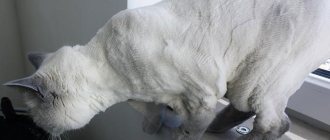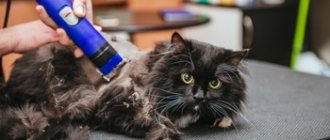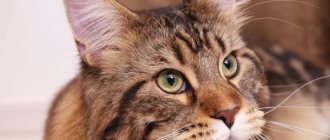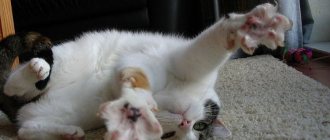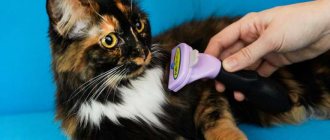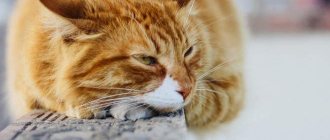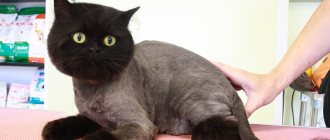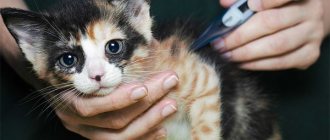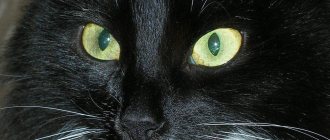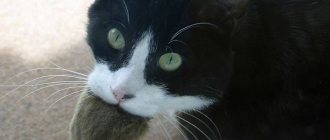My-Perfect.ru
Women's site about everything
Popular
How to Determine Your Face Type
Home › Other
Many of us have probably seen more than once in magazines or on the Internet photographs of cats with lion-like haircuts. Someone says: “Oh, how lovely! “, someone smiles: “People have nothing to do, they’re making fun of animals,” and someone openly wrinkles their nose: “What a horror! Just a mockery! " Without going into the reasons for each of the possible statements, one can nevertheless note their general detail: such opinions are made based on our purely aesthetic assessment of the haircut. And few people think about the physiological (or more precisely, hygienic) significance of this procedure.
It's no secret that short-haired cats are much easier to care for than long-haired ones. And often, even when we try to give our furry pet maximum attention and care, we still do not carefully care for its fur. For example, professional groomers recommend daily brushing of the hair of cats of Persian, Siberian, exotic (American Persian), Himalayan, Norwegian Forest and some other breeds. It is also recommended to use special balms, conditioners, and sprays to keep the coat in perfect condition. Of course, we cannot always allocate time for such procedures, which require a lot of patience, attention and accuracy. And sometimes the obstinate nature of cats becomes an obstacle to brushing and proper care, because many of them, for various reasons, are reluctant to expose their back, neck and tummy to brushes, slicker brushes and combs.
At the same time, irregular brushing of cat hair prevents its natural renewal and deprives the cat of a light but beneficial massage of the skin and superficial muscles. While licking itself, the cat swallows the fallen hairs, which combine into dense lumps in the stomach. Most often, the cat is able to regurgitate the ingested fur, but in advanced cases, these lumps can create serious problems, leading to gastrointestinal obstruction.
The hair that falls out is retained in the living (growing) hairs, gradually accumulating into tangles. A small matted lump can be removed using scissors (if the character and temperament of the cat allows this to be done safely), lightly cutting it along and combing it out with a comb, or simply cutting it out “at the root” (however, in this case a rather noticeable and not very aesthetic bald spot is formed ). However, it happens that tangles begin to cover quite large areas of the skin and it becomes almost impossible to remove them on your own. The cat's skin under such "felt rugs" made of wool is subject to additional heat, which can lead to various dermatological problems. In addition, in such a tangle, under the force of incessant twisting and compaction, more and more hairs are pulled out of the skin, which gives the cat an unpleasant sensation; she is reluctant to move so as not to expose herself to pain, loses her appetite and becomes lethargic (in fairness, it should be noted that chronic the appearance of tangles may indicate a metabolic disorder or vitamin deficiency, which requires consultation with a veterinary specialist). In this case, there is only one way out - a haircut.
Cat haircuts can be roughly divided into home and show.
First category of haircuts
is intended for non-show cats and is designed to make life easier for their owners in terms of grooming.
The most popular non-show haircut is the French Lion
. This model involves cutting the hair with a machine from the line of the elbow joint to the tail along the entire circumference of the body, while the body remains covered with hair 2-3 mm long. The tail is left untouched (a la “squirrel”) or cut, leaving the hair at the level of 4-5 vertebrae from the tip of the tail, resulting in a large fluffy brush. The front legs are usually cut to the elbow joint, the hind legs to the hock. The remaining “mane” is carefully trimmed with scissors to give a well-groomed, even look.
“Summer” (“Puss in Boots”) haircut
This is a kind of modification of the “French Lion”, characterized by the absence of a mane (only the head remains uncut) and sometimes a smaller tassel at the tip of the tail. Both haircuts will come in handy if your pet suffers from mats that are impossible to comb out.
Cats that regularly participate in exhibitions have their fur on their bellies and sides trimmed at the end of spring, leaving their back, paws and tail completely untouched. There are also special complex exhibition haircuts “Modern”, “Continental”, “Harlequin”
and others that require certain training, experience and skill from the groomer.
After grooming, it is recommended to wipe the cat with a damp towel to remove any remaining short, hard hair, then with a dry towel or dry the hair with a hairdryer. Often a haircut (especially an exhibition model) is combined with washing, drying and styling.
Separately, it should be said about methods that make haircuts safe and effective, since not all cats are delighted with this procedure. The simplest and most reasonable is to fix (hold) the cat by two people, while a third person does the cutting. This applies if the cat is not initially aggressive and is not capable of causing serious wounds (although in any case it is recommended to trim the cat's claws first). If the disposition and character of your pet is such that there are significant doubts about the safety of the groomer and his assistants, it is better to agree in advance on the possibility of using sedatives. In modern practice, it is usually not hypnotic drugs that turn off consciousness that are used, but muscle relaxants that reduce excessive muscle tone and limit the animal’s mobility. As a rule, a haircut with muscle relaxation is carried out by a veterinarian with the necessary professional knowledge and skills, who decides on the possibility of using sedatives in accordance with the age, state of health and character of the cat. Paw tying and other similar methods are not practiced by competent specialists, since the stress a cat receives can be much more dangerous than the effects of sedation.
Depending on the length and thickness of the coat, haircuts can be carried out 2 to 4 times a year.
Grooming at the beginning of summer will provide your pet with optimal heat exchange and protect him from overheating in the heat. And if you, for example, let your cat out for a walk around your summer cottage, then after the walk the short, cropped coat (especially in light-colored cats) will immediately notice a possible unwanted parasitic guest, which can be quickly removed without allowing it to attach to the skin. If you cut your cat's hair during the cool season, be especially careful and avoid drafts in the room where she lives.
Hygienic cat grooming
Grooming domestic cats is not considered a mandatory procedure. But many breeds often need their coats shortened. Otherwise, the wool constantly gets tangled and tangled. Owners have to brush their pet regularly. Grooming the animal solves the problem, so owners of fluffy cats will not have a question about why cats are groomed. Let's take a look at existing cat haircuts and hairstyles.
Types of haircuts
Grooming at home is necessary for some purebred cats. For example, the Persian or Scottish breed needs to have its coat shortened. It may also be required for those cats who have health problems. The following types of haircuts are distinguished:
- hygienic;
- medicinal;
- decorative for the British;
- exhibition.
a hygienic haircut if the animal has a lot of fur. If the fur becomes tangled and tangles have formed in it, the animal needs to be trimmed. It is also possible to carry out a hairdressing procedure if the animal’s fur is contaminated. Quite often, small furry creatures get into paint, plaster or cement. It’s not often that owners manage to wash away dirt with shampoo.
In some cases, this version of the procedure is performed for old or sick animals. After all, pets can take care of their fur on their own. But in the case when, due to age, this becomes impossible. Then this procedure can be avoided.
Hairdressing procedures can be used for preventive purposes. To avoid the formation of hairballs in the stomach. Cat haircuts are especially relevant in the summer season. To prevent your beloved pet from overheating, it is worth trimming it. They also resort to trimming their fur during shedding. In this case, keeping a pet is greatly simplified.
Therapeutic haircuts are prescribed by a veterinarian. The main indications for the procedure may be the presence of one of the following diseases:
- parasites - quite often cats, regardless of their breed, are attacked by fleas or lice;
- dermatitis - can be a food and household allergic reaction;
- various infectious diseases affecting the skin ;
- In case of hyperplasia of the sebaceous glands, the cat's haircut is mandatory.
Removing hair from the animal's body allows for effective treatment of the skin with medications. Moreover, this option reduces the time spent on treatment. If the procedure is necessary for medicinal purposes, the cat can be shaved bald.
Modeling and decorative art is a new type of art for pets. Grooming of British and Persian cats is especially popular. As a rule, a cat does not need such a procedure, and this is rather a whim of its owner. Through this manipulation, the owner of the animal can express the character of the cat or its individuality.
The last option for a possible haircut is an exhibition one . This type of haircut is carried out only in specialized salons, where the groomer brings the cat’s appearance to the breed standards. A high-quality haircut can only be performed in a specialized salon. But quite often, having the necessary tools at hand, the animal owner will be able to do it himself. Therefore, it is useful for everyone to know how to trim a cat.
Types of cat haircuts
In fact, there are not many cat haircuts, and all of them do not depend on the gender of the animal.
Hygienic
This haircut, also called a domestic haircut, is recommended for long-haired breeds:
- Norwegian cats;
- Nevsky Masquerade;
- Somali, Angora, etc.
A hygienic haircut is performed using a clipper with attachment No. 3, leaving the cat with 3 mm long hair. This length is very comfortable: the wool does not prick and does not cause itching. The pet's skin becomes plush or velor to the touch.
Rarely, in particularly complex cases of animal skin diseases, it becomes necessary to trim a cat using attachments No. 1 and 2.
During a hygienic haircut, the fur is left untouched only on the head, from the middle of the paws and at the tip of the tail.
Attention! Under no circumstances should you completely cut off the hair from the tail. Cats begin to chew on their hairless tails, leaving deep wounds. At least one third of the tip of the tail must be left uncut.
Model
Often the organization of a model haircut is justified by the desire to emphasize the individuality of the animal, or simply the owners want to be at the height of fashion. Also, model haircuts are performed on animals participating in exhibitions, which is why such haircuts are also called exhibition haircuts.
Model haircuts are performed with nozzle No. 3. In addition, thinning and hairdressing scissors and various combs are used. Below are the most common types of model haircuts.
Haircut “A la lion”
This is the most current cat hairstyle on show. It is performed on a hygienic basis, which allows you to achieve 2 goals at once: remove tangles in certain places and create a new image for your pet. During the work, the master completely cuts off the hair from the animal’s body, leaving only the hair on the head and the tip of the tail.
At the same time, the owner himself chooses the length of the fur left in these places.
Frequency of haircuts
The frequency of this procedure is mainly related to the regrowth of the animal’s skin. British cats' fur grows from three to six months. The rate of fur growth depends on the breed, age and state of his health. It is recommended to cut an ordinary cat with thick hair no more than three times a year. But if the procedure is aimed at removing tangles, it is carried out as needed.
Model procedures for British cats can be done more often. Everything will depend on the Briton himself. The same can be said about hygienic and therapeutic haircuts. They are performed as needed.
How to trim a cat's hair yourself
An animal owner interested in cat hairstyles should know that after an ordinary haircut, the animal's fur changes. Not only the structure, but even the color may change. Many breeds are not recommended to be cut due to a genetic tendency to darken their coat. And also too frequent haircuts lead to the fact that the coat no longer grows back.
In some Persian and Scottish cats, after hairdressing procedures, the hair may become thinner and roll into tangles more intensely. The negative consequences of such a hairstyle include skin injuries. As a result, an inflammatory process may occur.
Pros and cons
As mentioned above, there are undoubtedly benefits from grooming cats. This includes relieving the animal of unpleasant sensations caused by the tightening of the skin by tufts of matted hair, alleviating the pet’s condition in the heat, and significantly reducing the amount of hair in the house during the cat’s molting. The latter is especially true for owners suffering from allergic reactions to animal fur, as well as for young children.
In addition, a haircut significantly transforms and ennobles even the most ordinary-looking cat and turns it into a beautiful and graceful animal.
However, in addition to the obvious benefits, haircuts also have their disadvantages. One of the most important negative aspects is a violation of the thermoregulation of the animal’s body, due to the fact that rough interference occurs in the natural skin conditioning mechanism provided by nature. As a result, after removing part of the fur, the animal’s body temperature changes, and it becomes vulnerable to drafts and direct sunlight.
Another weighty argument against cutting is the deterioration in the condition of the coat after regrowth. There are frequent cases of noticeable degradation of the hair structure and changes in color. But this is not the main thing, since the most dangerous consequence of cutting cats is the extreme stress that most animals experience, especially those getting their hair cut for the first time. After the procedure, many pets become seriously depressed and often become ill due to nervousness. It is also worth mentioning here the known cases of animals dying from cardiac arrest during shearing.
Grooming of British cats
In order for the owner of the animal to correctly perform the hairdressing procedure, you need to have all the necessary tools in front of you. Grooming a British cat requires the following equipment:
- place for grooming British cats. An ordinary table (high and stable) or an ironing board is suitable for this;
- scissors with rounded edges;
- pet clipper.
In addition, you can visit a specialized store where you can find many interesting tools for pets. If you plan to trim a long-haired animal, you can buy a trimmer that will help you do this procedure correctly. Its job is to properly sharpen the blades. They do not allow injury to the animal's skin.
If the British dog does not like the noise of an electric clipper, it is best to use scissors and cut the animal by hand. When working with any device, precautions must be taken. During the hairdressing procedure you will need a comb . A sparse comb is best .
Before you start grooming your Persian cat, it is advisable to treat each tool with a disinfectant . You will also need a friend to hold the animal. But if your cat reacts restlessly to any manipulation performed on it, it is best to carry out the procedure at a veterinary clinic. It is not recommended to calm your cat with medications at home.
Haircut types
The presence of serious reasons for grooming a beloved cat, as well as the desire of owners to periodically change the appearance of their pet, led to the presence of two types of procedures:
- model;
- hygienic cat grooming.
Grooming salons operate at a professional level and are guaranteed to be injury-free. Trimming a cat at home will be more difficult, but it is also possible: either call a professional, or try to do it yourself.
Hygienic
If you get yourself a long-haired cat, be prepared, you will have to master professional grooming skills. Sooner or later you will be faced with the need to groom cats at home for purely hygienic purposes in order to:
- save from overheating;
- get rid of tangles, tangled or stuck together strands that cannot be combed.
Veterinary indications for clipping are:
- skin diseases and gastrointestinal problems;
- the old age of the cat, when he can no longer cope with his fur coat on his own;
- increased secretory activity. Including sebaceous or paraanal glands.
Model
Grooming cats for the purpose of implementing decorative ideas or changing their appearance is a real art. It’s quite difficult to realize your fantasies at home.
Usually, for complex cat grooming, they turn to professionals. Only they can guarantee you the result you are looking for. Don’t forget to find out in advance how much it costs to cut your furry pet’s hair and compare reviews of salons.
However, there are also simple options that will completely satisfy your creative impulse.
Short-haired British: rules and options
Before carrying out the procedure, the cat must be bathed with special hygienic shampoos and conditioners. It is recommended to wash the animal's skin three days before cutting. Then it will be easier to comb your furry pet. To avoid injury during the procedure, it is recommended to wear special pads and trim the animal’s claws. A British man's haircut can only be done if the basic rules are followed:
- Using a machine, it is possible to remove hair from the sides, back and belly of your pet;
- For the procedure, a nozzle number three is used - this is 3 mm;
- Before cutting, you need to treat the skin with a disinfectant;
- to trim the armpits you need to change the attachment to number two;
- then cut off the back of the body. You can leave a tassel on the tail, like a lion;
- the fur on the paws can be trimmed slightly, leaving beautiful “socks” or “knee socks”;
- the head is cut only with scissors; they can be used to trim the hair.
This is interesting: Popular Surnames on VK
Popular cat haircuts
Grooming a cat is a troublesome task, and here only your imagination will help you create an interesting composition. A variety of wildlife-inspired looks transform many cats. You can cut a cat's hair like a lion. Then you will need a machine to carry out this procedure with the animal. And also the dragon haircut, which is popular today, will allow you to show the individuality of the animal.
A cat's lion haircut is universal. It is used as a model hairstyle. This option, by the way, comes in hot summers. There shouldn’t be any difficulties in doing this hairstyle yourself. Socks are left on the limbs. And the base of the tail is completely drawn out, leaving only a small brush.
Another popular option is the dragon haircut. She is an unusual mohawk, which can be seen on the back of the cat. To completely reproduce the original image, the head is left in the same form. Only the fluff on the body is trimmed. From the spine to the tail the cat is cut in the form of triangles. Some craftsmen leave small pieces of wool. But everything will depend only on your imagination.
Model haircuts for cats of various breeds are a popular trend that anyone can master. A lion haircut is easy to do; with a simple set of tools, it is quite possible to do it yourself. A dragon is a challenging task that only an experienced groomer can handle.
Price list for cat grooming and cat grooming
* Grooming includes a lion haircut for a cat, claw trimming, and care consultation.
Cat grooming
| Cats/cats | from 1399 |
| Grooming cats without the client's help | from 2500 |
| from 250 | |
| from 500 |
An integral part of the price list for cat grooming and grooming is, in principle, the price of the haircut itself. If you have turned your attention to this procedure for the first time, then you may be faced with the following problems - this is the ubiquitous flying hair around the apartment, tangles on the body of cats and cats, which have a detrimental effect on the health of animals. What do you need to know when applying for the first time? It doesn’t matter whether it’s a short-haired British cat, a bobtail cat, or a long-haired Persian cat, or a Siberian cat, they are all united by the presence of hair on their body. The only representative who does not need our services is the Sphinx for today.
Cats are divided by type into long-haired - semi-long-haired, with curly hair, wire-haired, short-haired and hairless. And they all have one basic hairstyle model - lion style. But we note that at the beginning of our century, the groomer Alfred developed a new type and direction in grooming by developing new haircuts for cats - cascade, dragon, which became the progenitors of chinchilla hairstyles and others, and he also became the “father” of creative coloring of cats and dogs in Russia. Therefore, the range of hairstyles we have expanded is used by groomers all over the world and practically, but not in every salon in our city. If you need a “cat couture” hairstyle, then contact us.
Super options for cutting cats or “I killed the cat”!
“Don't waste money on psychologists and family therapy. Shave everyone!” – this call was made through the suffering of the author, who shaved his cat and found quiet happiness. Apparently - temporary, but no less sweet!))
Read this heartbreaking story, and then look at haircut options...for your family...
“Mitya the cat was so matted that it was easier to buy a new one than to comb this one out. However, we decided to give him a chance, after all, he is not a stranger in our family. We decided to shave it. Otherwise, the paws would soon be soldered in tangles to the stomach. While I’m constantly giving birth to children here, it turns out that the cat grooming service has long been firmly established on the market. You can cut it like a lion, or like a puma. You can shave a curly mohawk. There are only five options for cutting the tail. You can make silicone attachments for your claws! To prevent the cat from tearing up the furniture. Nozzles can be colored!!! You can stick rhinestones on the cat.
A technician is on call 24 hours a day. That is, if you suddenly get the idea at night to urgently trim your cat’s hair, please just choose a tail style. I love our country for this. Somewhere there are people on duty, looking at the phone, holding a hair clipper in their hands, checking it (vzh-vzhzh...), waiting for your call. Barsik, Leninsky district, urgent departure!
A girl came. The head is half shaved. She grabbed our mat and in ten minutes turned him into a Yorkshire terrier. It turned out that Mitya has legs, before that we thought that he was an arctic fox in front, a hare in back - that’s the whole cat. Still hidden by fur! Mitya became incredibly suede. The best part is that we now have a new animal. The old cat was annoying at times. He loved to come to the children when I FINALLY put them down and start meowing in a deep chesty bass (MUAAAAH, MUAAAAH...) I rushed after him and stepped in the sticky stuff. It turned out that the cat had brought shit from the toilet on fur pants and dropped it. And here I stand. Night. Children are screaming. And you need to wash your feet. Floor. Kota. Put the children to bed. And I'm completely screwed in every sense. Several times I told Dima, who came home from work: “I killed the cat.” And he believed. But now the cat is new, it’s like he’s unfamiliar to us. And it doesn’t infuriate me at all, because I haven’t saved it up yet. I’m thinking that the whole family should shave regularly. So that everything is suede and new. Strangers are so polite, it’s unusual to touch each other. Don't waste money on psychologists and family therapy. Shave everyone! And you need to shave just before winter. Because the cat Mitya became very affectionate, very. After all, we have a blanket.
For Mitya we chose the “Double Flux” haircut.”
(Text and photo of Mitya from here.)
Why cut your cat's hair?
It may seem that cat grooming is a whim of owners who do not know what to do with themselves. After all, hundreds and thousands of animals live on the street and in people’s houses, and no one cuts their hair. Indeed, sometimes a cat’s hairstyle is done solely because of the owner’s desire to decorate their pet and make it more unique. But, in most cases, this is a necessity.
There are a variety of reasons to trim your pet's hair.:
Tangles . Many cat breeds have fairly long and thick hair. Representatives of wild breeds tolerate heat better and their fur coat does not lose its appearance in any situation. But not all owners of “rich” fur coats are so lucky. For example, the hair of a Persian cat quickly mats, loses its appearance and becomes covered with tangles. Removing mats is necessary not only to improve the aesthetic appearance of your pet. They can cause the following troubles :
- skin tightening;
- pain on the skin under the mat;
- psychological discomfort for the animal;
- blood flow disturbance;
- heat exchange disturbance;
- the appearance and proliferation of various bacteria.
In the most advanced cases, even insect larvae and the insects themselves can be found in the tangles.
It's hot . During the summer heat, cats suffer from high temperatures just as much, if not more, than people. Wild breeds are more adapted to a wide variety of natural and weather conditions and can more easily tolerate heat. But furry domestic breeds suffer throughout the hot season. Their heat exchange is disrupted. Due to increased body temperature, the load on all systems and organs of the cat increases. The animal's activity and appetite decrease.
Swallowing and regurgitation of fur . All cats intensively brush their coats several times during one day. During this process, it is inevitable that some wool will be swallowed. Then the owners are faced with regurgitation of lumps of this fur in a variety of places. The process of regurgitation itself is quite unpleasant for the animal itself, and the results of this are quite unpleasant for the cat’s owners. If a cat does not regurgitate hair, it means that it is either excreted in the feces or accumulates in the gastrointestinal tract. This may subsequently lead to intestinal obstruction and may require surgery.
Medical reasons. Sometimes cats may need a haircut due to various diseases. :
- skin diseases (dermatitis, lichen);
- parasites (fleas);
- diseases of the gastrointestinal tract;
- overactive sebaceous glands.
The need to cut your cat's hair may arise for other reasons. Having a pet at home leads to some inconvenience and owners have to get used to new conditions, change and develop new habits. Fluffy cats require much more attention, and their beautiful coat can cause difficulties and troubles. Owners often resort to cutting their pets for the following reasons:
- Wearing contact lenses . Cat fur remains on household items and flies in the air. Getting foreign objects on contact lenses is extremely undesirable.
- Allergy to wool . Of course, the most reasonable option is not to have furry pets if you have such an allergy. However, giving away your furry friend is also not the best option for most owners. Grooming your cat will greatly improve your health.
- Inability to pay due attention to regular combing of the animal . Fluffy cats need to be brushed every day. As a last resort - 3-4 times a week. In the absence of this care procedure, tangles will form. A haircut eliminates the issue of combing for several months.
- Order in the house . Fluffy cats inevitably leave a lot of hair on furniture, floors, carpets and clothes. Not every owner has the time, desire and sufficient patience for regular, thorough cleaning and removal of fur. Grooming your cat reduces the amount of fur shed. Also, a haircut is practically a salvation during the molting period.
When a haircut is the only option
Caring for the long hair of Persians, Angoras, Maine Coons, Siberian or Norwegian cats and other mustachioed “shaggy cats” is a very troublesome task. A little started, especially during the molting period, and now tangles appear under the armpit, in the groin or on the “pants”, which tighten the skin and cause pain to the cat.
And the skin under a matted hairball becomes a “risk zone”: it rots and blood flow is disrupted. As a result, fungi and bacteria develop in this place.
An animal’s attempt to get rid of mats on its own is fraught with injury, because the hair that the cat still manages to lick becomes clumps in the stomach (the so-called trichobezoars) and causes vomiting. Or, worse, these clots clog the gastrointestinal tract.
It turns out that one problem entails many others, and to solve them comprehensively, sometimes it’s enough just to cut the cat’s hair.
How often should you cut your cat's hair?
The frequency of such a procedure as grooming a cat depends on several factors. There is no average recommendation that would be suitable for all cats.
First of all, you should consider the type of coat and its length. Long-haired and very fluffy cats should be trimmed a little more often than pets with less luxurious fur coats. Fluffy, but trimmed cats feel much better and become more active and cheerful. Short-haired purrs usually do not require a haircut at all.
Owners who plan to participate in exhibitions should be quite careful and attentive when deciding to resort to such a service. The haircut should not be too short and should not be done later than 6 months before the planned event. It should also be remembered that the regrown coat may have a different structure from the original one. In rare cases, the color of the coat may change slightly.
Few cats will be happy about the haircut procedure and, most likely, you will encounter resistance. Therefore, it may be necessary to administer special medications to calm the animal. And this is significant stress for the cat. And the procedure itself does not bring much pleasure to the pet. In order not to bring a lot of stress into the cat’s life, haircuts should be done no more than 2-3 times a year . If the pet is not in very good health and is quite timid, then it is better to limit the haircut to once a year, before the onset of heat. And throughout the year, maintain the good condition of the fur coat by combing.
What do you need to know and consider before the procedure?
If you still decide to cut your cat’s hair for certain reasons, then consider a few points:
- If a cat is going to participate in an exhibition, then it needs to be cut no later than six months in advance. In this case, you cannot cut your hair completely.
- Restless cats are given muscle relaxants before the session.
- After the shearing process, the animal’s coat structure and color may change, although this rarely happens.
- Some cats and kittens cannot regain their original coat for a long time.
- The fur on the face, head and ears should not be touched.
In addition, keep in mind that grooming is stressful for any animal, so it is advisable to refuse it if there is no need for it (for health reasons or exhibition).
You should not try to give your cat a fashionable haircut yourself. Moreover, use office scissors or a hair clipper used for people for this. If you are not a grooming master, then most likely you will disfigure the animal, and in the worst case, injure it.
The best option is when a specialist from a grooming salon comes to cut your pet’s hair at home. This is especially important if the cat is nervous before the procedure. The home environment will have a calming effect.
Before grooming, a cat should trim its claws to avoid wounds and scratches on the owners and the pet itself.
The frequency of haircuts is determined in each case individually, depending on the condition of the coat and the health of the pet. As a rule, cats are groomed no more than 2–3 times a year.
